
Narwhals are actual creatures that live in the Arctic waters of Greenland, Canada, and Russia.
©iStock.com/dottedhippo
Are narwhals real? Yes, it is true that these strange creatures exist. Narwhals, Monodon monoceros, are toothed whales with a huge protruding tusk. They belong to the Monodontidae family and live in the Arctic waters of Greenland, Canada, and Russia. They frequently swim in pods of 20.
There are around 80,000 narwhals worldwide, and they are near threatened due to human activity and global warming. If not for substantial global conservation efforts, the species could perish.
Is It True That Narwhals Exist?

Males are easily identifiable by their exceptionally long tusks that protrude from the upper jaw.
©Dotted Yeti/Shutterstock.com
Narwhals, together with the pure white beluga whale, are the only two living members of the Monodontidae family. Males are easily identifiable by their exceptionally long tusks. Tusks are teeth that protrude from the left upper jaw and past the lip, forming a twisting helix. This hollow ivory tusk is a sensory organ with up to 10 million nerve endings that connects the brain to external stimuli.
Unlike most toothed whales, the narwhal’s mouth is toothless. To the left of the upper left jaw, a male has a single long, straight tooth (tusk), which spirals in the opposite direction. In terms of the animal’s biology, the tusk dictates social structure, such as dominance hierarchies and ranks of males within pods.
Information on Narwhals

These incredible whales have a speckled black and white skin pattern and are white underneath.
©iStock.com/Vac1
Although Narwhals are difficult to study, we do know that they have adapted to be one of the deepest diving marine mammals, capable of diving to depths exceeding 5,905 feet. They spend a sizable portion of their lives below 2,625 feet. Keep reading to learn more about these fascinating creatures!
Appearance
Narwhals have a speckled black and white skin pattern and are completely white below. Monodon monoceros, the scientific name for these whales, translates as “one tooth, one tusk.” These whales are rarely studied, partly because they dwell in remote areas, in an environment that is dark for half the year, covered in ice for half the year, and difficult to access.
Diet
Narwhals have a seasonal diet, feeding heavily throughout the winter and little during the ice-free summer season. This feeding behavior is in direct contrast to those of other sub-Arctic whale species, which travel south during the winter and feed during the summer. According to scientists, the narwhal’s strong winter-feeding cycle may be an adaptation to the low productivity of the high Arctic summering areas, or a behavioral feature used to avoid competing with other whales feeding in the summer.
Greenland halibut, polar and Arctic cod, cuttlefish, shrimp, and arm hook squid comprise their prey. Their food requirements do not seem to alter by gender or age.
Migration
Narwhals migrate seasonally, with a high degree of loyalty to favored, ice-free summering grounds, which are typically in shallow waters.
Narwhals use ice fissures or holes to travel from pack ice to inshore seas in the winter. In the spring, they migrate to coastal areas, and in the fall, to open waters.
Diving
In their wintering seas, narwhals dive to depths of at least 2,620 feet at least fifteen times each day so they can feed, with many dives exceeding 4,920 feet.
Communication
Narwhals, like most toothed whales, use sound to navigate and seek food. Narwhal vocal repertoires are like those of closely related belugas, with similar whistle frequencies and durations. However, beluga whistles may have a wider frequency range and more varied whistle shapes.
How Long Has the Narwhal Been in Existence?

The narwhal was one of several species reported by Carl Linnaeus in his landmark 1758 Systema Naturae.
©Dotted Yeti/Shutterstock.com
Although we don’t know for sure how long the narwhal has been in existence, we know that narwhals are legendary animals, playing a part in history and folklore. The narwhal was one of several species reported by Carl Linnaeus in his landmark 1758 Systema Naturae 10th edition. The name derives from the Old Norse word nár, meaning “corpse,” so named because its skin resembles a human corpse.
The Vikings and other northern traders believed that narwhal horns had mystical abilities, such as the capacity to neutralize poison and cure melancholia. The tusks were make-shift cups that neutralized any toxicity in the drink. In 1555, Olaus Magnus correctly characterized a “narwal” as a fish-like monster with a horn on its head. Sir Humphrey Gilbert presented Queen Elizabeth I with a sterling narwhal tusk, for which she paid 10,000 pounds, the equivalent cost of a castle!
An enormous marine creature was described in Jules Verne’s novel Twenty Thousand Leagues Under the Sea. The narwhal was among two explanations for it. Originally, Verne stated that it would have been 60 feet long.
Is the Narwhal a Threatened Species?

Increased exposure to open water is an indirect threat for narwhals related to changes in sea ice.
©Dotted Yeti/Shutterstock.com
Are narwhals real, myth, or extinct? Narwhals are hunted for subsistence by only the indigenous Inuit people of the Arctic. Narwhals, like other sea mammals, have been extensively exploited for their abundant fat reserves. All parts of the narwhal are usable, including the meat, skin, blubber, and organs.
Increased exposure to open water is an indirect threat for narwhals due to changes in sea ice. In 2002, hunters in Siorapaluk reported an increase in narwhal catches that did not appear to be related to greater effort, hinting that climate change may be increasing the narwhal’s vulnerability to capture.
Additionally, seismic investigations conducted in conjunction with oil exploration have altered natural migration patterns.
The photo featured at the top of this post is © iStock.com/dottedhippo
Thank you for reading! Have some feedback for us? Contact the AZ Animals editorial team.






